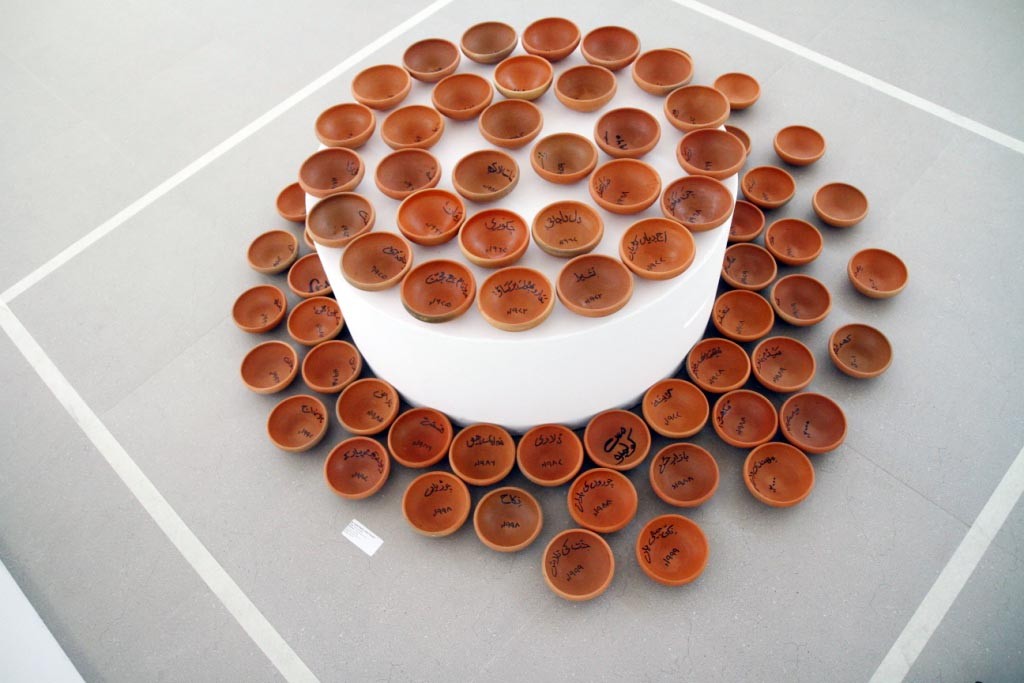
Fifty artists revisit and celebrate the glorious Pakistani films and actors of the past at the VM Art Gallery Karachi

There was a famous film, The Agony and the Ecstasy (1965) in which actor Charlton Heston portrayed Michelangelo -- the greatest of the Italian Renaissance artists. There are other foreign films that have been made about renowned artists. However, the group-show ‘Lights, Art…And Action!’ at the VM Art Gallery, Karachi that opened on November 23 takes the viewers to a tremendous nostalgic journey through a portraiture of Pakistani film icons. The idea of making films about iconic painters and sculptors thus gets turned on its head as 50 artists revisit and celebrate glorious Pakistani films and actors of the past by creating artworks based on them.
The show was inaugurated by Senator (Retd.) Javed Jabbar, himself an advertising icon and also a film-maker. The curator of the show is Munawar Ali Syed who is a practicing artist and a Visiting Faculty at two art schools in Karachi. ‘Lights, Art…And Action!’ is the opening event of the Pakistan Calling Film Festival, held in collaboration with the Visual Studies Department of Karachi University. The show will be on display until December 10, 2016.
Artists and film artistes are colourful, hyper-sensitive, and seen as rebels, and they also connect well with younger audiences. A number of young people were therefore present to view the works and to lend support to their friends participating in the show.
The much-admired superstars of Pakistani cinema of yesteryears, Waheed Murad, Nadeem, Mohammad Ali, and the beautiful Zeba stopped me in my tracks. Bholu ustad and his assistant’s live painting of the four was in progress on the front wall. It was good to see the cinema billboard painters in action as most of them have now turned to other vocations ever since the photographic blow-ups of film stars on panaflexes have taken over their craft.
Upon entering the upstairs gallery, a 3-D bearded head is jutting out from the wall on the right. A few items of clothing are also on display. Artist Asad Hussain depicts the malleability of identity of an actor in his Behind the scene in painted silicon wood. Perhaps it may have served the concept better if a few more ‘heads’ of the same ‘actor’ were installed showing different make-up, hair and beard styles.
Anam Shakil’s Nostalgia, a 24" x 36" canvas painted in acrylics, shows the classic celluloid couple, Zeba and Waheed Murad. Answering a question about the title of her painting ("surely it cannot be ‘nostalgia’ for you, as you weren’t even born then"), Shakil responded that the young girl in the painting watching the actors is herself, and it depicts those times when popular Pakistani movies were screened on the mini screen and watched by her.
An interesting installation in a darkened space of the gallery borrows its title from the title of the show itself. Several acrylic light boxes with laser engravings showing film posters glow in the dark. The four artists for this project are Noman Siddiqui, Sheema Khan, Haider Ali and Nabeel Karia.
Khalid Soomro, Zeeshan Memon and Habib Phulphoto have also jointly put together an installation, Piyaar tey Hathyaar using mixed media. It is an interesting concept, using hockey sticks, guns, spades, axes, etc., together with a movie flapper and a lighting fixture. After all, Pakistani movies of yore (in particular the Punjabi language ones) portrayed the themes of love and violent revenge hand in hand.
Aliya Yousuf’s installation, Nigar Awards catches this writer’s eye for its uniqueness of medium. Although Yousuf has been making ceramics and using the Urdu script as well, the 99 terracotta bowls with the titles of films and the year in which each of them received the award is a refreshing installation and a change from all the colour in the gallery. There can be different interpretations, but for me it relates to the temporal and fragile nature of stardom despite the heights gained by the actors and their films at one time or the other.
Nurayah Sheikh Nabi’s The Storyboard; morph of the dragon dance is an installation of ten wood-cut etchings and transfers. Anyone familiar with animation and film will find these of much interest.
VASL Artists’ Collective has put up a 32.5" x 54" digital print; Advanced Booking, composed of photographs formatted in the shape of an old ticket. Each of the numerous images depicts the decline of Pakistani cinema houses. The empty spaces and bare billboards underscore the slow death of the ones that still exist.
There are several other artworks that deserve mention but paucity of space restricts me. Though viewers are taken through a striking artistic journey of the yesteryear films through various mediums, it is difficult to say what kind of connection is formed by the young generation of artists with their art. As opposed to have actually experienced living in that era and watching the movies of those iconic stars who ruled the hearts and minds of the Pakistani people, there seems to be a borrowed sense of nostalgia. I say this as they did not imitate the hairstyle of Waheed Murad; the coyness of Zeba; the pout of Madam Noor Jehan, or danced the Twist and Cha-cha-cha imitating Neelo and Rani, or wore flowers in their hair and applied bindiya like Shabnam. They did not live in the ‘teddy’ era or that of the bell-bottoms and flowery skirts. They have only watched the old flicks on their computers and television sets, as regretfully, some of them may have little or no recollection of going to the cinema houses outside of the culture of the cineplexes inside shopping malls in the city that thrives today.